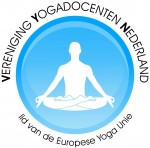The Africa Yoga Project – Using Yoga to Build a Community
On February 7, 2020, a new issue of Dutch magazine Yoga International came out, featuring an article about the Africa Yoga Project in Kenya. I’m also in it, telling more about my experiences in Kenya last Summer and about my plans for the Happiness, Hugs and Handstands Tour, which is coming to the Netherlands in June this year. I got permission to share the entire article here (in translation). Enjoy reading!
THE AFRICA YOGA PROJECT
Using yoga to build a community
“When you’re in Nairobi, be sure to attend a community class of the Africa Yoga Project (AYP),” Irene Vos (50), a yoga teacher from Ommen (the Netherlands) with special ties to Kenya, advised me. Once in Nairobi, every yogi I met asked if I’d already been there. Being a critical alignment adept of a certain age, I kinda dreaded doing two hours of power yoga with three hundred other people. “Just do it,” my sister-slash-yogi told me over the phone, “and if it gets too overbearing, assume child’s pose.”
Written by Mar Oomen; Image by Jose Meboer, Mar Oomen
I find myself standing on the only mat that’s still available, in a huge room on the top floor of a multi-company building in Nairobi. On my right, a large, friendly-looking Kenyan young man, on my left, one of the few other white women in the room. On the endless black rubber mats in front, beside, far aside, and even on the mezzanine above us, people, mainly young Kenyan men and women, sit packed together. At the very front of the room is a sound installation. A tall man with dreadlocks takes care of the music.
Dancing to ecstatic music
Today, the class is taught by American Paige Elenson, who founded the Africa Yoga Project in 2007. It’ll be an afro yoga class, she promises. The group cheers agreeing. After chanting “om”, we quickly pick up the pace. Paige expertly guides us through several yoga postures, alternated with upward and downward facing dog for relaxation.
The large young man next to me bravely joins in. He comes here every week, he beams, as we lean on each other during a balance exercise. About halfway through class, we take turns dancing in a circle in the middle of the room. The circle gets bigger and bigger, the music becomes increasingly ecstatic. And then, we can finally catch our breath, lying down on our backs, before we begin the floor exercises.
The classes are rightly called community classes, says Elima Wanjiku (32), program manager and one of the first yoga teachers of AYP. “People from all sorts of backgrounds come here every Saturday. Some arrive in expensive cars, others on foot because they can’t afford the bus. People who work together, move together, feel united. Isn’t that the meaning of yoga, to be united? Nobody judges, everybody does the best they can. And during lunch, strangers become friends.” The community classes are free, that is to say, you donate what you can spare, and there’s free lunch after: rice with kidney beans, some vegetables, and chapatis.
From the slums to a real house
About ten years ago, Wanjiku and her one-year-older sister lived in a tiny shack made of iron sheets in one of Nairobi’s slums, sharing one washbasin and one toilet with ten other families.
Her sister earned a living as an acrobat. Her troupe performed for tourists, on the street, in hotels, and in safari parks. The story goes that the American Paige Elenson, who, at the time, was on safari in Kenya with her family, showed the acrobats that she, a power yogi, could stand on her hands too. One thing led to another and before they knew it, they were doing yoga together. The acrobats were so impressed with the exercises that they begged Elenson, now returned to America, for more. At the time, yoga was an unknown phenomenon for most Kenyans in Nairobi. Expats practiced it, and many Indians, and for the latter, most Kenyans thought, yoga was part of their religion, a way of life. Many Indians practiced it in their temples, after all. Thanks to Elenson’s postures, the acrobats discovered that they, too, could benefit greatly from yoga. In addition to making them strong and flexible, yoga made them calmer. “And that was exactly what we needed in Kenya at the time,” Wanjiku says, seated at one of the long wooden tables of the yoga center’s lunchroom.
The aftermath of the electoral violence that had caused many casualties, especially in the slums of Nairobi, was still felt daily. The tension between the different population groups was palpable. Nobody trusted each other anymore. After Paige Elenson received another plea – “teach us more, our country needs yoga” – she decided to return to Nairobi. She joined forces with American power yoga guru Baron Baptiste and set up a teacher training program. Its purpose: to offer yoga training to unemployed, young people like Elima Wanjiku, so that they can earn a living wage teaching yoga. And, simultaneously, to make yoga accessible to everyone, by providing free classes for as many people as possible. And that, as we can see ten years on, was pretty successful. Thanks to her income as a yoga teacher, Wanjiku now has her own car and her own apartment, with her own laundry room and toilet. “Teaching private yoga classes to the middle and upper class especially pays well,” she says.
“People who work together, move together, feel united”
Making yoga accessible
There are about three hundred other stories like Wanjiku’s. In Nairobi, but also elsewhere in the country, numerous yoga studios have popped up. Yoga classes are also offered in gyms and in training facilities of residential buildings. These classes generally offer Baron Baptiste’s Power Yoga. But, thanks to visiting yogi like Dutch Irene Vos or Indian Arvind Pathak who came to Nairobi in 1992 to start a center for naturopathy and teach Ashtanga Yoga, you can also practice other forms of yoga in Kenya. Irene Vos became involved with the Africa Yoga Project in 2016. She is the adoptive mother of a Kenyan girl and knows the country well. During her visit in 2009 in preparation for the adoption, it had already crossed her mind: yoga should become accessible to all Kenyans, not just the well-to-do. When she read about AYP a year later, she thought: I want to be part of this.
As a mentor, she sponsored a student for a year. The plan was to have monthly meetings, regarding topics like how to set up your own business, what things should you pay attention to, and what are your strengths and weaknesses. Irene Vos: “David, my mentee, wanted to combine yoga with roller skating and rollerblading, which he was really good at. He never got the chance. I met him twice via skype. The meetings went great. From the very first moment, we clicked. But for our third meeting, David didn’t show up. No matter how many times I tried, I couldn’t reach him. I later heard from AYP that he was killed. Murdered. I never found out why.”
International Day of Yoga
After a disappointing experience with her next mentee – “He was unable to keep his appointments” -, Vos decided to put her mentoring on hold and first visit the Africa Yoga Project herself before sponsoring a new student. And so, last Summer, she (and her model spine) visited Nairobi to teach trainees the basic principles of Critical Alignment Yoga. Thanks in part to her efforts, the Shine Center now also offers Restorative Yoga classes. Other classes you can take are Ashtanga, Acro, and pregnancy yoga. It’s a pity, says Arvind Pathak, that Power Yoga holds such popularity in Nairobi. “Power yoga is an intense type of yoga, and can be too difficult for some, especially for elderly people. It’s a missed opportunity, because, in principle, yoga is really simple and accessible.”
“On that day, all yogi in Kenya do yoga together”
Because the training program is heavily sponsored abroad and classes are free, it’s difficult for ‘regular’ yoga centers to compete, and some are in danger of going under. Yet, Pathak is happy about the rising popularity of yoga. The International Day of Yoga, celebrated in Kenya for the last five years thanks to the efforts of the Indian government, attracts more people every year. “On that day,” he says, “all yogi in Kenya do yoga together. Black, brown, white, Indian, all differences disappear. Last year, no less than 3700 people took part in the main event in Nairobi. 3700! Just try to imagine what it’s like to do yoga with so many people. That’s community building, at its very best!”
For more information, go to:
HANDSTANDS, HUGS & HAPPINESS TOUR
To raise money for the Africa Yoga Project, Irene Vos organizes a Handstands, Hugs & Happiness Tour in June 2020. Two teachers from the Africa Yoga Project will visit the Netherlands to teach yoga classes. Irene is looking for yoga studios and festivals interested in hosting and/or willing to help generate awareness and donations. Irene Vos: +31 6 81 47 20 01 / [email protected].
For those interested
Are you interested in yoga and would you like to experience the benefits of yoga yourself? You can! The exercises are easy to learn and (with a bit of practice) can also be done at home. If you don’t live in or nearby Ommen, our Online Back Care Basics program offers a great alternative! Or join our free 6-day challenge “From Back Pain to Back Gain” first, and discover what yoga can do for you!
If you live in the neighborhood or are visiting Ommen, feel free to visit us. Or sign up for a trial class or a private class.


